PF3D7_1335300 reticulocyte binding protein 2 homologue b (RH2b)
Disruptability [+]
| Species | Disruptability | Reference | Submitter |
|---|---|---|---|
| P. falciparum 3D7 |
Possible |
19400777 | Theo Sanderson, Wellcome Trust Sanger Institute |
| P. falciparum 3D7 |
Possible |
USF piggyBac screen (Insert. mut.) | USF PiggyBac Screen |
Mutant phenotypes [+]
| Species | Stage | Phenotype | Reference | Submitter |
|---|---|---|---|---|
| P. falciparum 3D7 | Asexual |
Attenuated |
19400777 | Theo Sanderson, Wellcome Trust Sanger Institute |
Imaging data (from Malaria Metabolic Pathways)
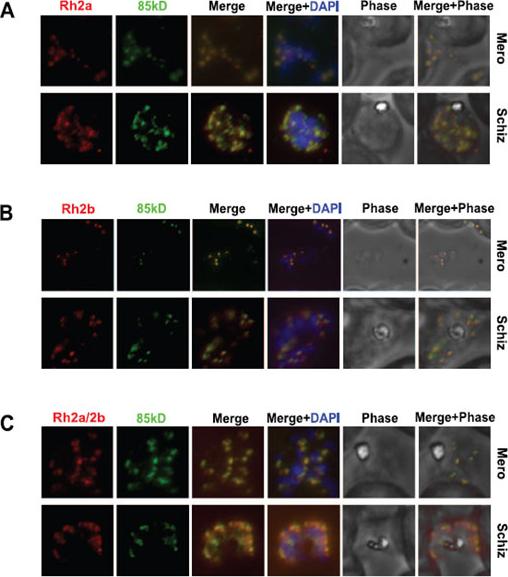
The 85 kDa processed form of PfRh2a and PfRh2b colocalises with the corresponding C-terminal regions in both merozoite and schizont stages. (A) The 85 kDa product co-localises with the C-terminal PfRh2a product. Free merozoites or schizonts of the 3D7 parasite were dual stained with 8F9 anti-PfRh2a and R1170 anti-85 kDa antibodies. Both merozoites and schizonts give an apical staining pattern with both antibodies, indicating co-localisation. Nuclei were stained with DAPI. (B) The 85 kDa product co-localises with the C-terminal PfRh2b product. Parasites were dual stained with 4B7 anti-PfRh2b and R1170 anti-85 kDa antibodies. As for (A), both antibodies give a co-localised apical staining pattern. (C) The 85 kDa product co-localises with both the PfRh2a and PfRh2b C-terminal products. Parasites were dual stained with 3A2 anti-PfRh2a/2b and R1170 anti-85 kDa antibodies. As for (A), both antibodies give a co-localised apical staining pattern.Triglia T, Chen L, Lopaticki S, Dekiwadia C, Riglar DT, Hodder AN, Ralph SA, Baum J, Cowman AF. Plasmodium falciparum merozoite invasion is inhibited by antibodies that target the PfRh2a and b binding domains. PLoS Pathog. 2011 Jun;7(6):e1002075.
See original on MMP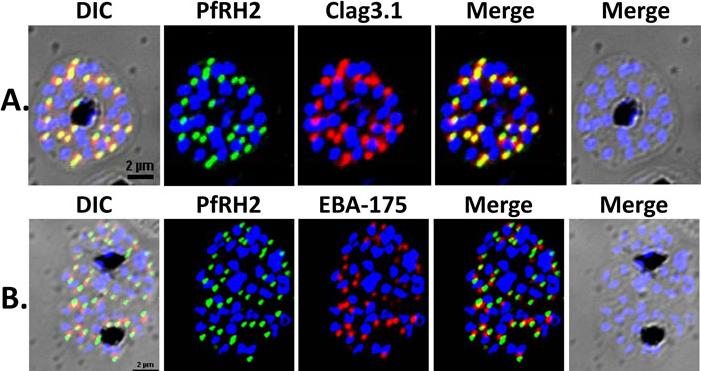
Localization of PfRH2a/b by immunofluorescence confocal microscopy. (A) 3D7 schizonts were dual labeled with anti-rPfRH240 mice sera and anti-clag3.1 rabbit sera. Mature schizonts immunolabeled with anti-rPfRH240 were stained with Alexa 488 linked anti-mouse IgG secondary antibody (green). Schizonts labeled with anti-clag3.1 rabbit sera were stained with Alexa 594 linked anti-rabbit IgG secondary antibody (red). (B) 3D7 mature schizonts were dual labeled with anti-rPfRH240 mouse sera and anti-EBA175 rabbit sera. Schizonts labeled with anti-EBA-175 antibodies were stained with Alexa 594 linked anti-rabbit IgG secondary antibody (red). PfRH2a/b co-localizes with the known rhoptry bulb marker protein, clag3.1 demonstrating that it is localized in the rhoptries, and not with the microneme marker protein, EBA-175.Sahar T, Reddy KS, Bharadwaj M, Pandey AK, Singh S, Chitnis CE, Gaur D. Plasmodium falciparum reticulocyte binding-like homologue protein 2 (PfRH2) is a key adhesive molecule involved in erythrocyte invasion. PLoS One. 2011 6(2):e17102.
See original on MMP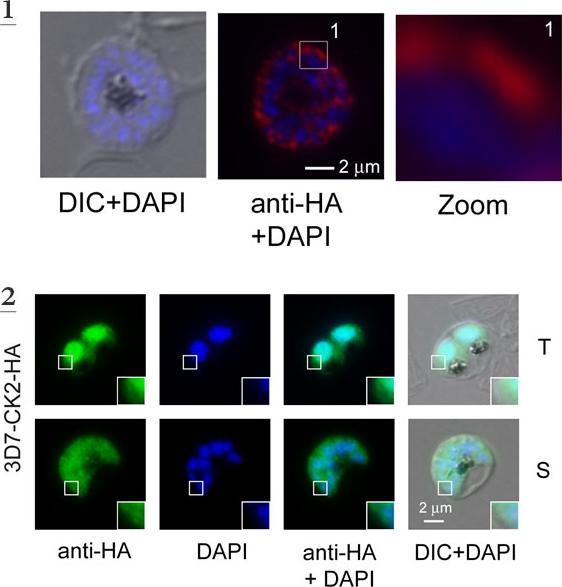
1. In vivo phosphorylation of S3233 (S3233 is the sole phosphoacceptor site in the cytoplasmic domain of Rh2B for in vitro phosphorylation by parasite extract) in schizonts . Expression was verified by IFA using anti-HA antibodies. Scale bar indicate 2 μm. Rh2B is localized at the apical pole of nascent merozoites.2. Expression, purification of PfCK2 alpha (endogenously HA-tagged (3D7-CK2-HA, PF3D7_1108400) and Rh2b in vitro phosphorylation. Immuno-fluorescence microscopy using endogenous derived PfCK2-HA alpha. Localization with the anti-HA antibodies (green) confirmed expression in the nucleus (blue, DAPI) and cytosol of fixed parasites in the trophozoite (T) and schizont (S) stage. Scale bar indicates 2 μm. Enlargements of selected areas are marked with a white square the endogenous tagged protein was localized in the parasite´s cytosol, as well as in the nucleus of trophozoite stage parasites. In the schizont stage of the parasite the dual localization of endogenous tagged CK2 was less pronounced and appeared predominantly cytosolic.Engelberg K, Paul AS, Prinz B, Kono M, Ching W, Heincke D, Dobner T, Spielmann T, Duraisingh M, Gilberger TW. Specific phosphorylation of the PfRh2b invasion ligand of Plasmodium falciparum. Biochem J. 2013 452(3):457-66
See original on MMP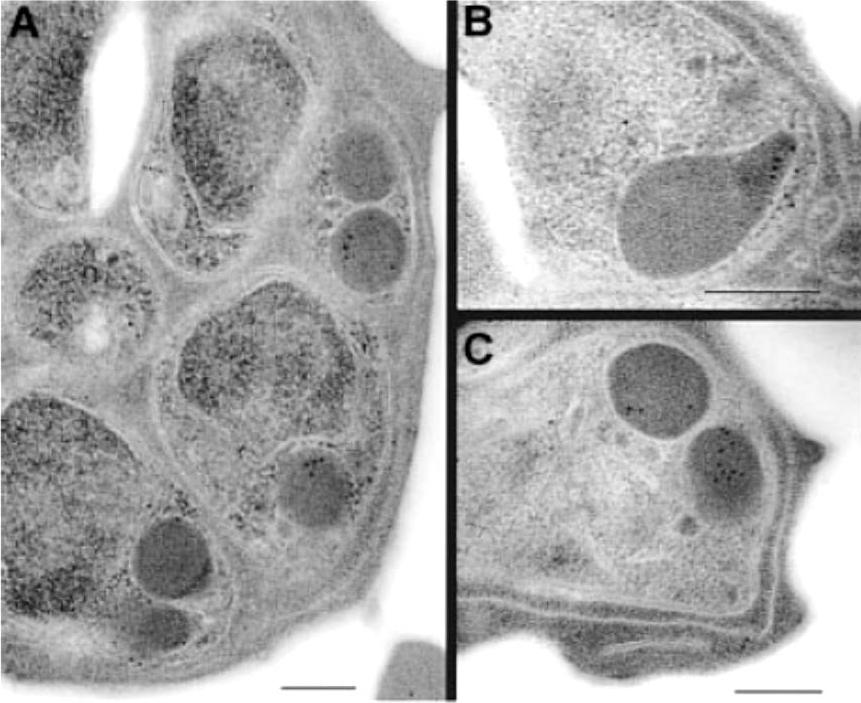
Subcellular localization of PfRh2a/b in 3D7 parasites by immunoelectron microscopy. (A-C) Cross-sections through merozoites. Scale bars are 200 nm in all panels. Immunoelectron microscopy with anti-PfRh2a/b antibodies showed labeling in the electron-dense rhoptry organelles of the parasite (A and C), with label evident in the neck of the rhoptry in some parasites (B).Duraisingh MT, Triglia T, Ralph SA, Rayner JC, Barnwell JW, McFadden GI, Cowman AF. Phenotypic variation of Plasmodium falciparum merozoite proteins directs receptor targeting for invasion of human erythrocytes. EMBO J. 2003 22:1047-57.
See original on MMP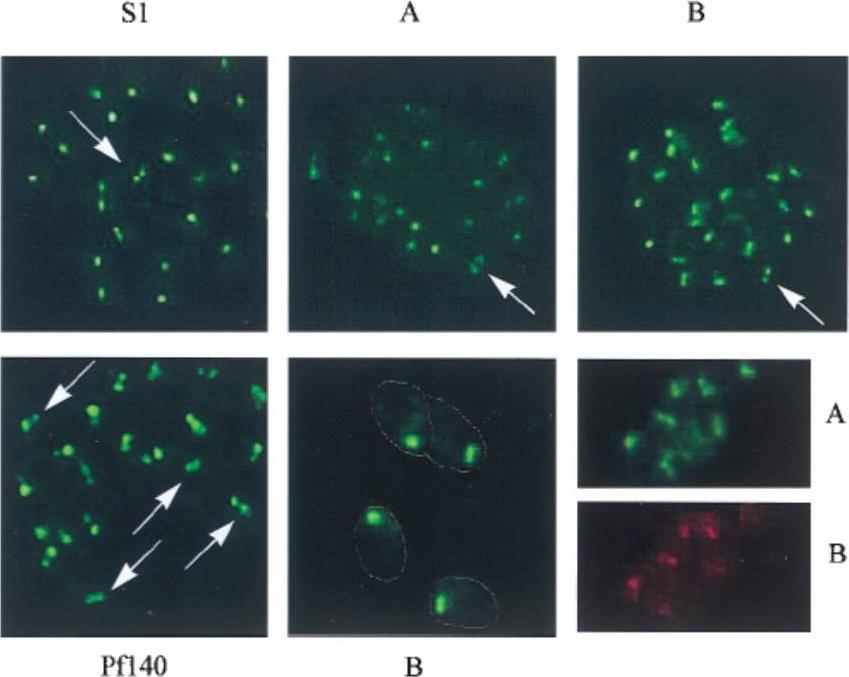
Immunofluorescence assays performed with antisera against fragments of the shared domain (S1), fragments of the unique regions, anti-PfRBP2-Ha (A) and anti-PfRBP2-Hb (B), and the rhoptry antigen Pf-140, on air-dried, acetone-fixed, P. falciparum-infected erythrocytes. The lower center panel (B) is at a higher magnification (33,750; others are 31,250), with the outline of the merozoites marked. The lower right shows costaining of single merozoites with rabbit anti-A serum (A) and rat anti-B serum (B). Each of the PfRBP2-H antisera, whether raised against fragments of the shared domain, anti-S1 and anti-S3, or against the unique regions, anti-A and anti-B, yielded a punctate staining pattern, generally with a single dot of fluorescence, although occasionally two foci were visible in a single merozoite (marked by arrows Upper). This double-dot pattern is reminiscent of proteins such as the Pf140 protein, which are localized to the paired rhoptry organelles. Higher magnification (Lower Center) reveals that the staining is concentrated at the apical end of the merozoites.Rayner JC, Galinski MR, Ingravallo P, Barnwell JW. Two Plasmodium falciparum genes express merozoite proteins that are related to Plasmodium vivax and Plasmodium yoelii adhesive proteins involved in host cell selection and invasion. Proc Natl Acad Sci U S A. 2000 97:9648-53. Copyright 2009 National Academy of Sciences, U.S.A.
See original on MMP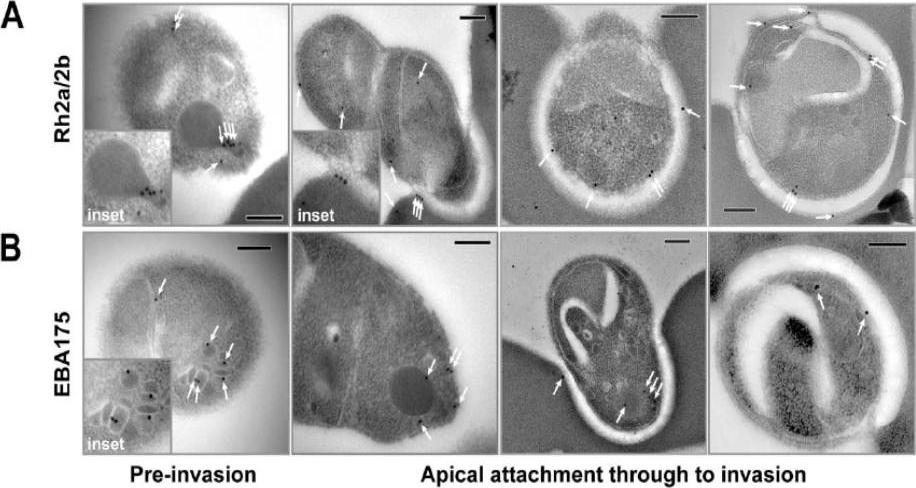
Immuno-electron microscopy localisation of PfRh2a and PfRh2b during merozoite invasion of human erythrocytes. (A) The PfRh2a/2b proteins localise to the rhoptry neck and moving junction of merozoites. Transmission electron micrographs of pre- and mid-invasion merozoites showing PfRh2a/b-specific immunogold labelling (white arrows). At the pre-invasion stage, PfRh2a/b localises to the rhoptry neck (inset), while during mid-invasion, PfRh2a/b localises both to the moving junction and to the merozoite surface within the invasion pit. Scale bar = 0.2 mm. (B) The EBA-175 protein localises to the micronemes and apical tip of merozoites. At the pre-invasion stage, EBA-175 is located within micronemes (inset), while during mid-invasion, EBA-175 can be located either at the apical tip or within the invasion pit. Scale bar = 0.2 mm.Triglia T, Chen L, Lopaticki S, Dekiwadia C, Riglar DT, Hodder AN, Ralph SA, Baum J, Cowman AF. Plasmodium falciparum merozoite invasion is inhibited by antibodies that target the PfRh2a and b binding domains. PLoS Pathog. 2011 (6):e1002075.
See original on MMP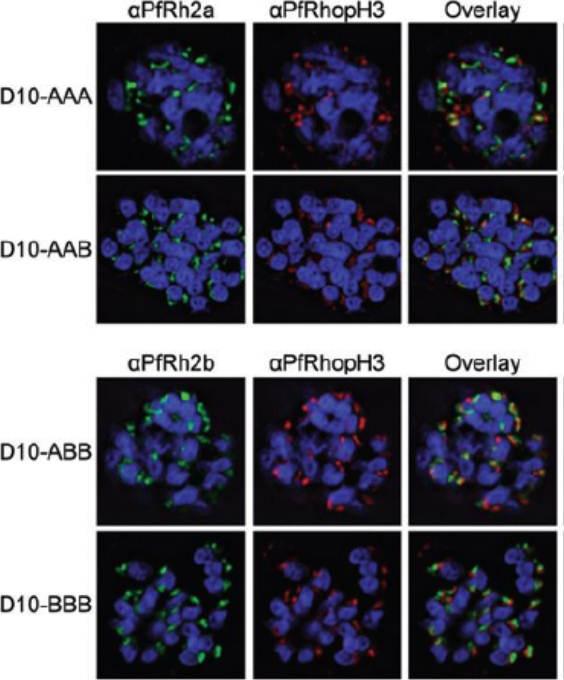
Chimeric protein localization and processing. D10-AAA, D10-AAB, D10-ABB and D10-BBB schizonts were methanol-fixed and stained with rabbit anti-PfRh2a or rabbit anti-PfRh2b, mouse anti-PfRhopH3 and DAPI. Images were obtained using deconvolution microscopy. The chimeric proteins from both D10-AAA and D10-AAB localized to the apical organelles (Fig. 3A, left panel) and in close proximity to PfRhopH3 (middle panel). Fluorescence overlays showed some direct colocalization between the PfRh2a/b proteins and PfRhopH3 (right panel). PfRh2a and PfRh2b are known to localize to the rhoptry neck whereas PfRhopH3 localizes to the rhoptry bulb.Dvorin JD, Bei AK, Coleman BI, Duraisingh MT. Functional diversification between two related Plasmodium falciparum merozoite invasion ligands is determined by changes in the cytoplasmic domain. Mol Microbiol. 2010 75:990-1006.
See original on MMP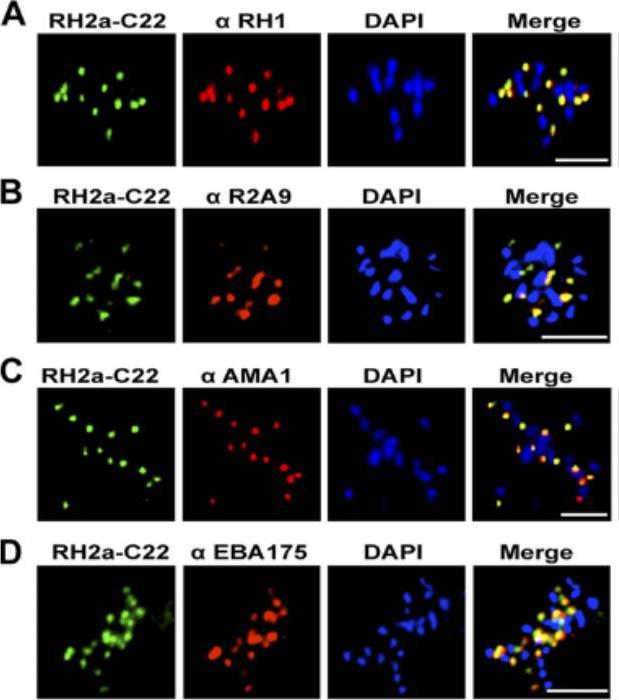
An immunofluorescence assay was performed on late-schizont-stage W2mef parasites stained for RH2a using the anti-RH2a MAb C22 and costained either with an antibody against the rhoptry neck marker RH1 (A), rabbit polyclonal antibody R2A9, recognizing both RH2a and RH2b (B), or an antibody against the micronemal marker AMA1 (C) or EBA175 (D). Bars, 5 mm. PfRH2a showed a punctate pattern at the apical tip of the merozoite in schizonts and appeared to colocalize with PfRH1 in W2mef and 3D7 parasites, strongly suggesting that RH2a is located at the rhoptry neck.Gunalan K, Gao X, Liew KJ, Preiser PR. Differences in erythrocyte receptor specificity of different parts of the Plasmodium falciparum reticulocyte binding protein homologue 2a. Infect Immun. 2011 79:3421-30.
See original on MMP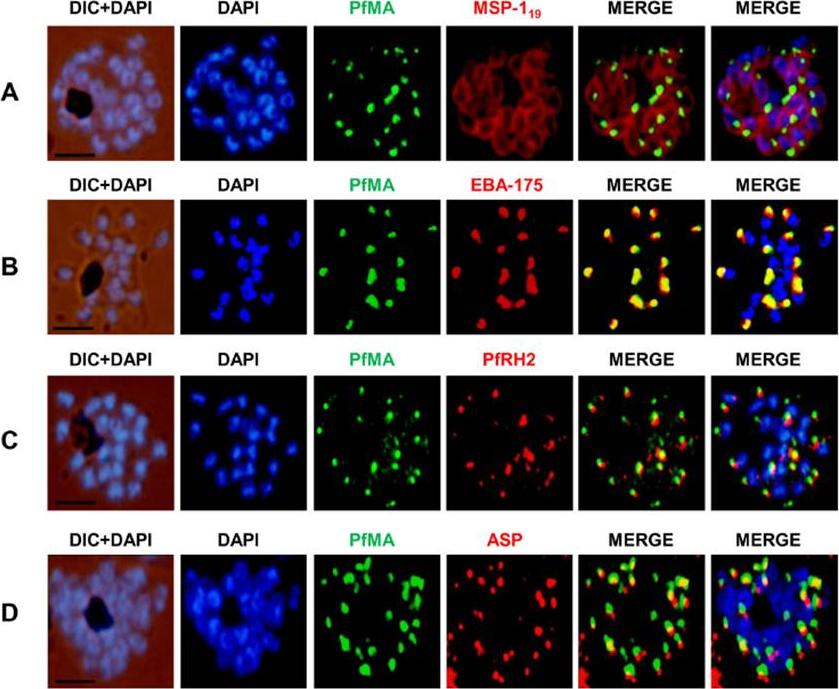
PfMA localization in schizont stages analyzed by fluorescence microscopy. Sub-cellular localization of PfMA was studied by co-immunostaining with surface protein (A), microneme (B), rhoptry (C, D) resident proteins. P. falciparum schizonts were co-immunostained with mouse anti-PfMA (green) and rabbit antibodies against one of the 4 marker proteins (EBA175/PfRH2, ASP, MSP-119) (red). The nuclei of schizont were stained with DAPI (blue) and slides were visualized by fluorescence microscope. All apical marker proteins and PfMA showed punctate staining in schizonts. PfMA was localized in the micronemes as it signal costained with micronemal marker EBA-175. The scale bar indicates 2 μm.Hans N, Singh S, Pandey AK, Reddy KS, Gaur D, Chauhan VS. Identification and Characterization of a Novel Plasmodium falciparum Adhesin Involved in Erythrocyte Invasion. PLoS One. 2013 8(9):e74790.
See original on MMP
PfARNP is localized in rhoptry neck of P. falciparum. Subcellular localization of PfARNP was studied by co-staining with antibodies against merozoite surface protein-119 (A), micronemal resident protein EBA-175 (B), rhoptry bulb protein Rh2b (C), and rhoptry neck, apical sushi protein (ASP) (D). P. falciparum schizonts were co-stained with anti-PfARNP (red) and anti-MSP-119, anti- EBA-175, anti-Rh2b, anti-ASP antibodies (green). The nuclei of schizonts were stained with DAPI (blue). All apical marker proteins and PfARNP showed punctate staining in schizonts distinct from DAPI. Co-staining of PfARNP with surface marker MSP-119 showed PfARNP localized at the apical tip with surface of merozoites stained by MSP-119. PfARNP staining did not merged with either EBA-175 or Rh2b indicating that it is neither a resident of micronemes or rhoptry bulb of merozoites. The labeling of PfARNP merged perfectly with ASP confirming its localization in the neck of rhoptries of P. falciparum. (Scale bar shows 2 mm). The panel on extreme right shows digital zoom of corresponding merged images.Hans N, Singh S, Jain SK, Chauhan VS. Identification of novel rhoptry neck protein of Plasmodium falciparum. Mol Biochem Parasitol. 2013 188(1):34-9
See original on MMP
PfTRAMP localizes to the rhoptries of P. falciparum schizonts and merozoites.(A) Co-localization of PfTRAMP with MSP1, EBA175 and Rh2b in schizonts and free merozoites by IFA. PfTRAMP (green) co-localizes with rhoptry marker PfRh2b (red) but does not co-localize with EBA175 (red) or merozoite surface marker MSP1 (red) in schizonts and merozoites. (B)Co-localization of PfTRAMP-GFP in transgenic P. falciparum 3D7 with MSP1, AMA1 and Clag3.1. PfTRAMP-GFP (green) co-localizes with rhoptry marker Clag 3.1 (red) but not with microneme markerPfAMA1 (red) or merozoite suface marker PfMSP1 (red) in schizonts and merozoites. Nuclei were stained with DNA intercalating dye DAPI.Siddiqui FA, Dhawan S, Singh S, Singh B, Gupta P, Pandey A, Mohmmed A, Gaur D, Chitnis CE. A Thrombospondin Structural Repeat Containing Rhoptry Protein from Plasmodium falciparum Mediates Erythrocyte Invasion. Cell Microbiol. 2013 15(8):1341-56
See original on MMP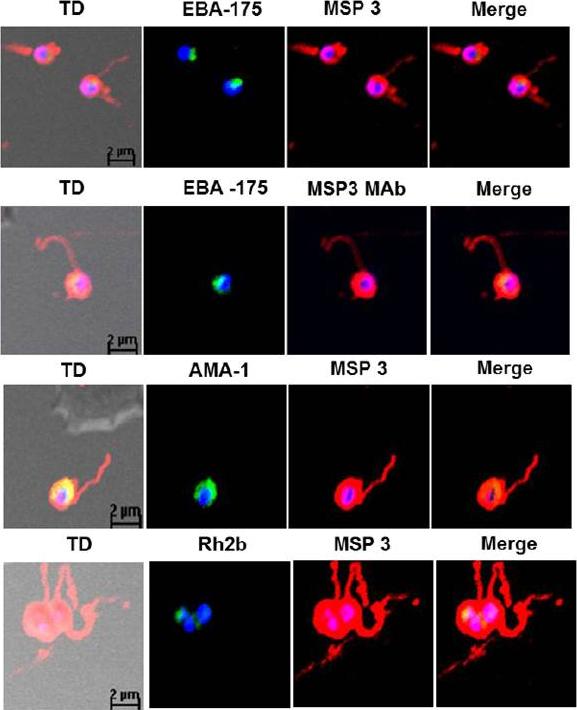
Detection of fibrillar structures in Plasmodium falciparum merozoites by immunofluorescence assay. Co-immunostaining of free merozoites with anti-MSP3 Abs along with Abs against EBA-175, AMA-1, Rh2b and MSP5. In all the slides long fibrous structure attached to free merozoite was detected by anti-MSP3 Abs. Monoclonal MSP3 antibodies also stained these fibrillar structures associated with merozoites, but other marker protein did not detect fibrillar assemblies. The long fibrils like structures attached at one end with merozoite surface were consistently seen to associate to distant erythrocytes as well as wrap around them.Imam M, Singh S, Kaushik NK, Chauhan VS. Plasmodium falciparum Merozoite Surface Protein 3: oligomerization, self-assembly and heme complex formation. J Biol Chem. 2013 289(7):3856-68
See original on MMP
Specific amino acid residues in the cytoplasmic domain are essential for PfRh4 function. Localization of PfRh4 and PfRh2 in Rh4-WT tail, RH4-AMA1 tail (PfRh4 tail was replaced with the cytoplasmic sequence of AMA1), Rh4-mut4tail ) contains the mutations S1667A, S1674A, Y1680A and Y1684A) and RH4-mut5tail (contains similar mutations with an addition mutation at S1652A within the PfRh4 cytoplasmic tail) lines as detected using anti-PfRh4 monoclonal and anti-PfRh2 polyclonal antibodies. Parasite nuclei were stained with DAPI. Rh4-mut4 tail and Rh4-mut5 tail expressed PfRh4 and all showed an apical localization similar to rhoptry protein PfRh2Tham WH, Lim NT, Weiss GE, Lopaticki S, Ansell BR, Bird M, Lucet I, Dorin-Semblat D, Doerig C, Gilson PR, Crabb BS, Cowman AF. Plasmodium falciparum Adhesins Play an Essential Role in Signalling and Activation of Invasion into Human Erythrocytes. PLoS Pathog. 2015 Dec 22;11(12):e1005343.
See original on MMP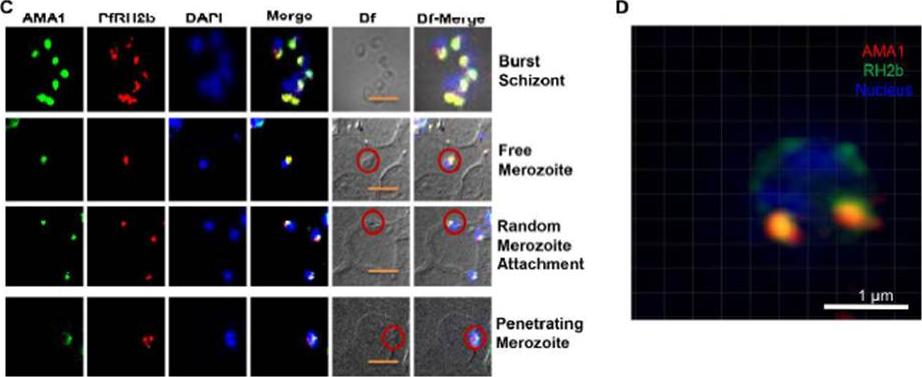
PfRH2b is associated with the moving junction during merozoite invasion. The process of merozoite invasion was closely monitored to locate the position of PfRH2b of burst schizont, free merozoites, random merozoite attachment, apposed merozoite and penetrating merozoite. The presence of PfRH2b (PfRH2b, red) at the moving junction was further confirmed with AMA1 (C, green) as common markers with punctuate staining. Merozoites of focus are shown with red circles. The bright field images labeled as Bf. Scale bar indicates 2 μm. (D) A sliceof a three-dimensional structured illumination microscopy (3D-SIM) on merozoite at the junction further confirmed the punctuated pattern of PfRH2b (green) to be in close proximity to AMA1 (red). Scale bar indicates 1 μm. In the merged images, areas of overlap between the red and the green signals are shown inyellow. DAPI (blue) stained for nuclei.Aniweh Y, Gao X, Gunalan K, Preiser PR. PfRH2b Specific Monoclonal Antibodies Inhibit Merozoite Invasion. Mol Microbiol. 2016 Jul 20.
See original on MMP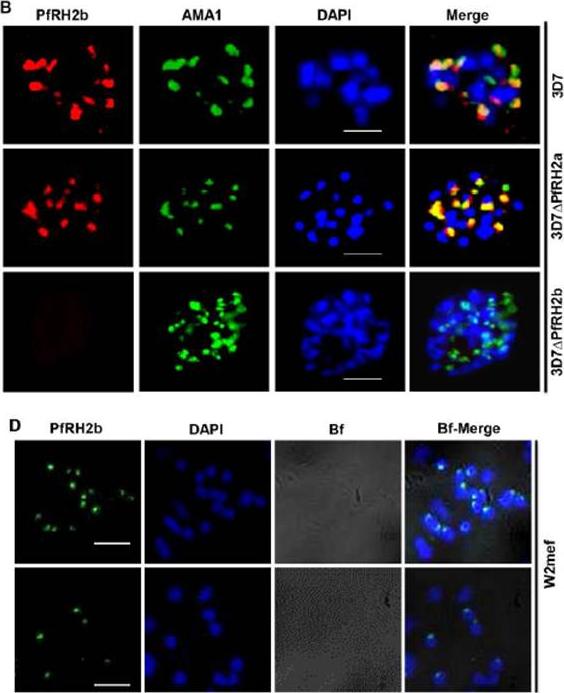
(B) IFA indicates the specificity of mAb A7 in schizont stage parasites. PfRH2b (PfRH2b, red) co-stained with AMA1 (AMA1, green), DAPI for nuclei (blue) in 3D7, 3D7ΔPfRH2a and 3D7ΔPfRH2b schizont. In the merged images, areas of overlap between the red and the green signals are shown in yellow. Scale bar indicated in white represents 2 μm. (D) Nonpermeabilized W2mef merozoites show surface expression of PfRH2b using mAb A7. PfRH2b shown green (RH2b A7), DAPI for nuclei (blue) and bright field (Bf) images shown in gray. Scale bar indicates 2 μm.Aniweh Y, Gao X, Gunalan K, Preiser PR. PfRH2b Specific Monoclonal Antibodies Inhibit Merozoite Invasion. Mol Microbiol. 2016 Jul 20.
See original on MMP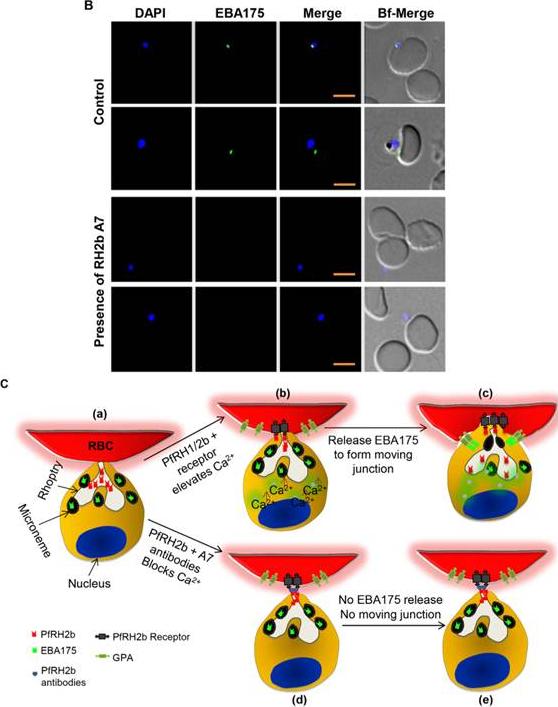
B. Representative images indicate the positivity of merozoites to EBA175 surface expression upon incubation with PfRH2b A7 or without A7 (Control). Merozoites nuclei shown in blue (DAPI) and EBA175 surface staining indicated in green color. Scale bar indicates 2 mm.C. Schematic of the effect of PfRH2b A7 on merozoite Ca2+ signalling and invasion. After the merozoite initially attaches to the RBC and reorient itself, PfRH2b is released from rhoptry neck aiding in the sensing of the RBC by engaging in apical end interaction with the surface of the RBC (a). The interaction between PfRH2b and its receptor triggers the increase of intracellular Ca2+ of the merozoite (b). The increase in cytosolic Ca2+ levels lead toa release of microneme proteins such as EBA175 to bind to its receptor glycophorin A (GPA). This therefore triggers the recruitment of other members leading to moving/tight junction formation (c). In the presence of PfRH2b A7 mAb, interactions between PfRH2b and its receptor is abrogated thereby affecting the intracellular Ca2+ increase (d) necessary for the release of EBA175. This, therefore, hinders recruitment of other proteins, such as AMA1,needed for merozoite tight junction formation. Hence no tight or moving junction is formed leading to invasion blocking.Aniweh Y, Gao X, Gunalan K, Preiser PR. PfRH2b Specific Monoclonal Antibodies Inhibit Merozoite Invasion. Mol Microbiol. 2016 Jul 20.
See original on MMP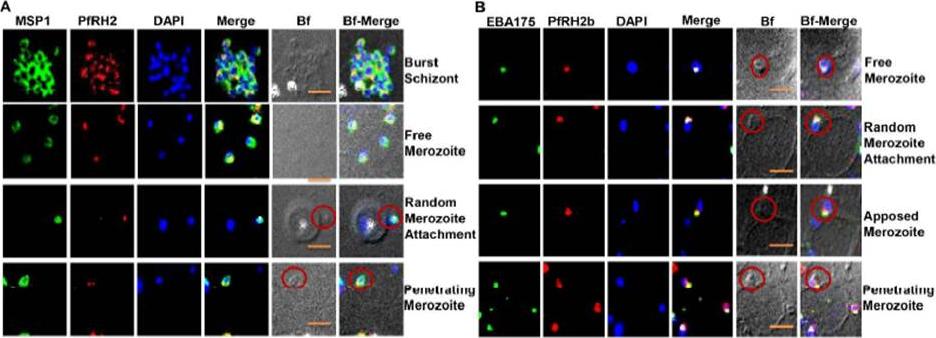
PfRH2b is associated with the moving junction during merozoite invasion. The process of merozoite invasion was closely monitored to locate the position of PfRH2b of burst schizont, free merozoites, random merozoite attachment, apposed merozoite and penetrating merozoite. (A) Merozoites were stained for MSP1 (MSP1, green) and PfRH2 (PfRH2, red). PfRH2 apical punctuate staining was observed in the free and attaching merozoites while in invading merozoites two punctuate staining were observed at the anchorage of the moving junction. The presence of PfRH2b (PfRH2b, red) at the moving junction was further confirmedwith EBA175 (B, green). Merozoites of focus are shown with red circles. In the merged images, areas of overlap between the red and the green signals are shown in yellow. DAPI (blue) stained for nuclei.Aniweh Y, Gao X, Gunalan K, Preiser PR. PfRH2b Specific Monoclonal Antibodies Inhibit Merozoite Invasion. Mol Microbiol. 2016 Jul 20. .
See original on MMP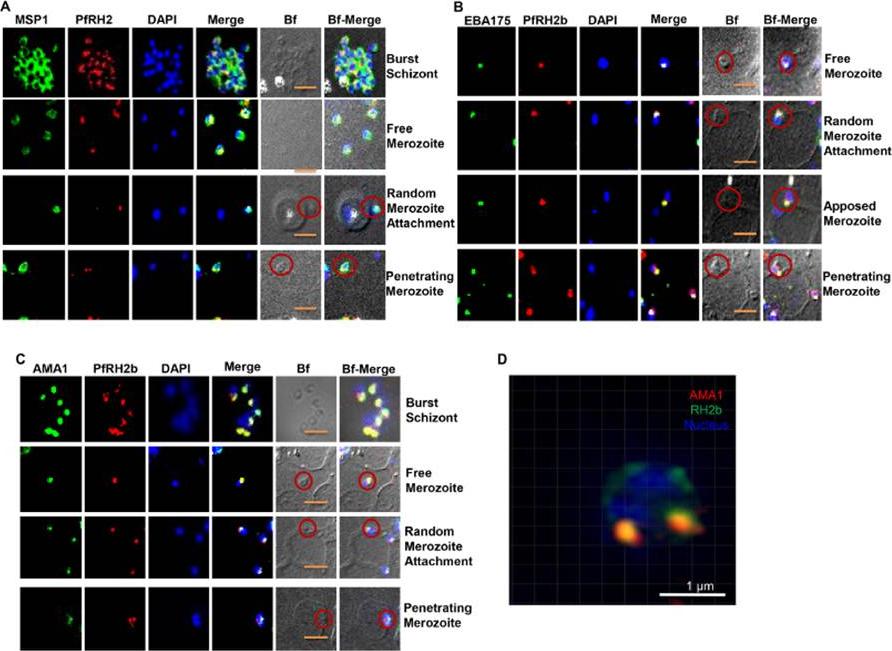
PfRH2b is associated with the moving junction during merozoite invasion. The process of merozoite invasion was closely monitored to locate the position of PfRH2b of burst schizont, free merozoites, random merozoite attachment, apposed merozoite and penetrating merozoite. A. Merozoites were stained for MSP1 (MSP1, green) and PfRH2 (PfRH2, red). PfRH2 apical punctuate staining was observed in the free and attaching merozoites while in invading merozoites two punctuate staining were observed at the anchorage of the moving junction. The presence of PfRH2b (PfRH2b, red) at the moving junction was further confirmed with EBA175 (B, green) and AMA1 (C, green) as common markers with punctuate staining. Merozoites of focus are shown with red circles. The bright field images labelled as Bf. Scale bar indicates 2 lm. D. A slice of a three-dimensional structured illumination microscopy (3D-SIM) on merozoite at the junction further confirmed the punctuated pattern of PfRH2b (green) to be in close proximity to AMA1 (red). Scale bar indicates 1 lm. In the merged images, areas of overlap between the red and the green signals are shown in yellow. DAPI (blue) stained for nuclei.Aniweh Y, Gao X, Gunalan K, Preiser PR. PfRH2b specific monoclonal antibodies inhibit merozoite invasion. Mol Microbiol. 2016 Nov;102(3):386-404.
See original on MMP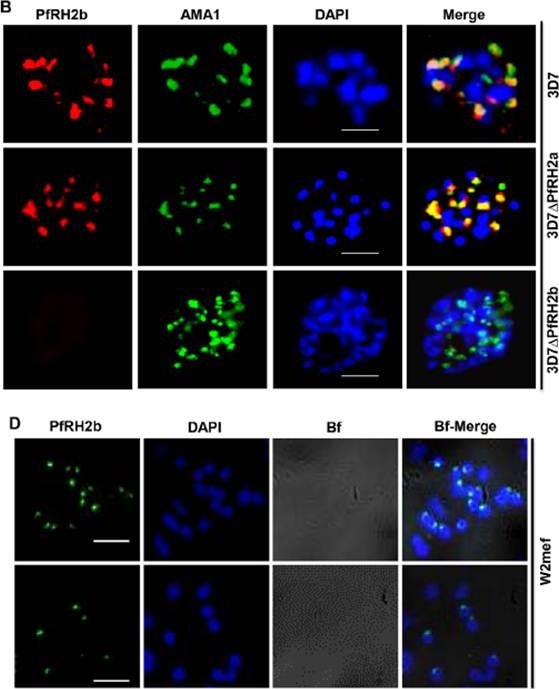
B. IFA indicates the specificity of mAb A7 in schizont stage parasites. PfRH2b (PfRH2b, red) co-stained with AMA1 (AMA1, green), DAPI for nuclei (blue) in 3D7, 3D7DPfRH2a and 3D7DPfRH2b schizont. In the merged images, areas of overlap between the red and the green signals are shown in yellow. Scale bar indicated in white represents 2 mm. D. Non-permeabilized W2mef merozoites show surface expression of PfRH2b using mAb A7. PfRH2b shown green (RH2b A7), DAPI for nuclei (blue) and bright field (Bf) images shown in gray. Scale bar indicates 2 mm. (3D7DPfRH2a (clone in which PfRH2a has been deleted), 3D7DPfRH2b (clone in which the PfRH2b gene has been deleted) parasites. The punctate staining pattern observed for A7 was in close proximity to the staining observed with an antibody targeting the micronemal protein Apical membrane antigen 1 (AMA1), indicating an apical location of PfRH2b within the merozoite.Aniweh Y, Gao X, Gunalan K, Preiser PR. PfRH2b specific monoclonal antibodies inhibit merozoite invasion. Mol Microbiol. 2016 Nov;102(3):386-404.
See original on MMP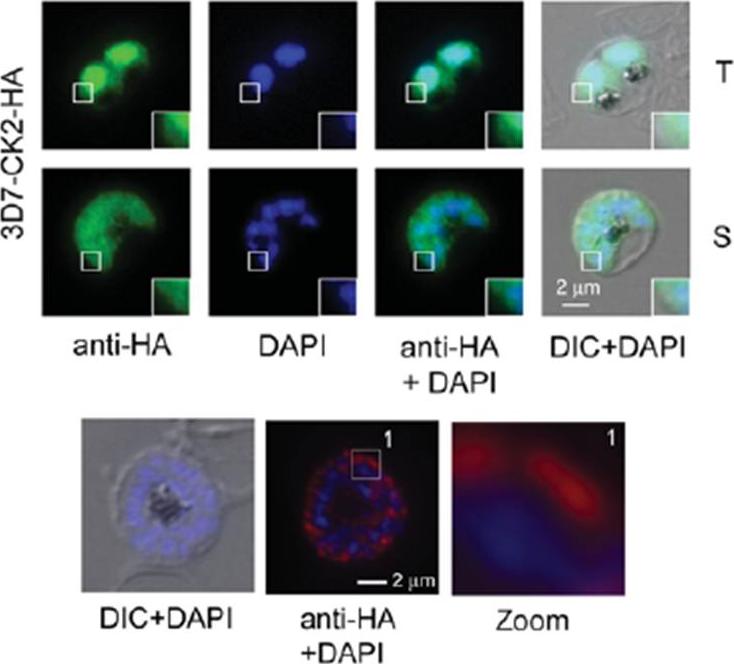
Upper pannel: Immunofluorescence microscopy using endogenously derived Pf CK2α–HA. Localization with the anti-HA antibodies (green) confirmedexpression in the nucleus (blue, DAPI) and cytosol of fixed parasites in the trophozoite (T) and schizont (S) stage. Scale bar indicates 2 μm. Enlargements of selected areas are marked with a white square. DIC, differential interference contrast microscopy. PF3D7_1108400. The endogenously tagged protein was localized in the parasite’s cytosol, as well as in the nucleus of trophozoite stage parasites. In the schizont stage of the parasite the dual localization ofendogenously tagged CK2 was less pronounced and appeared predominantly cytosolic. Lowe pannel: Expression of Rh2b–HA was verified by IFA using anti-HA antibodies. Scale bar, 2 μm. DIC, differential interference contrast microscopy. Rh2b–HA is localized at the apical pole of nascent merozoites.Engelberg K, Paul AS, Prinz B, Kono M, Ching W, Heincke D, Dobner T, Spielmann T, Duraisingh MT, Gilberger TW. Specific phosphorylation of the PfRh2b invasion ligand of Plasmodium falciparum. Biochem J. 2013 Jun 15;452(3):457-66.
See original on MMPMore information
| PlasmoDB | PF3D7_1335300 |
| GeneDB | PF3D7_1335300 |
| Malaria Metabolic Pathways | Localisation images Pathways mapped to |
| Previous ID(s) | MAL13P1.176 |
| Orthologs | |
| Google Scholar | Search for all mentions of this gene |